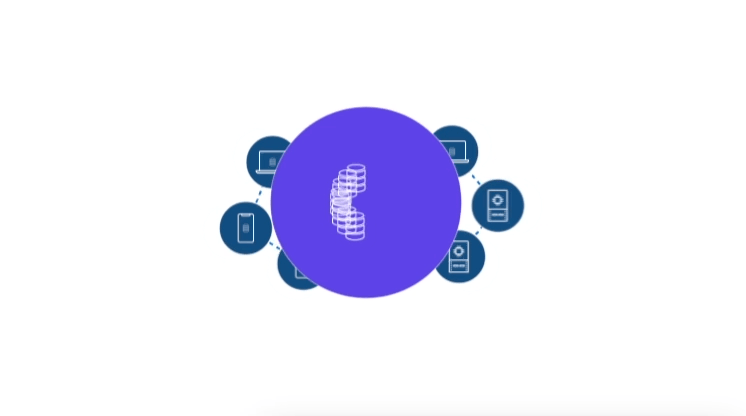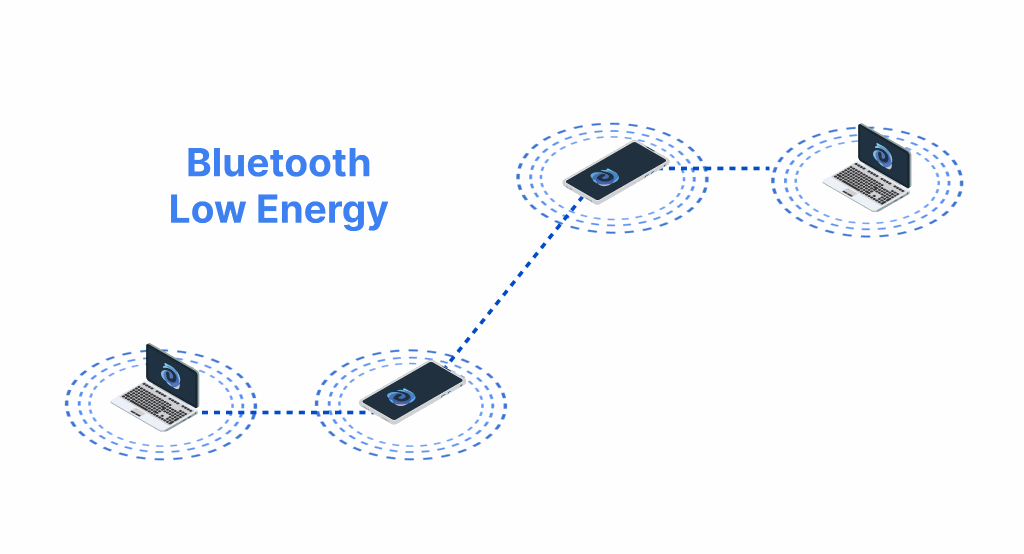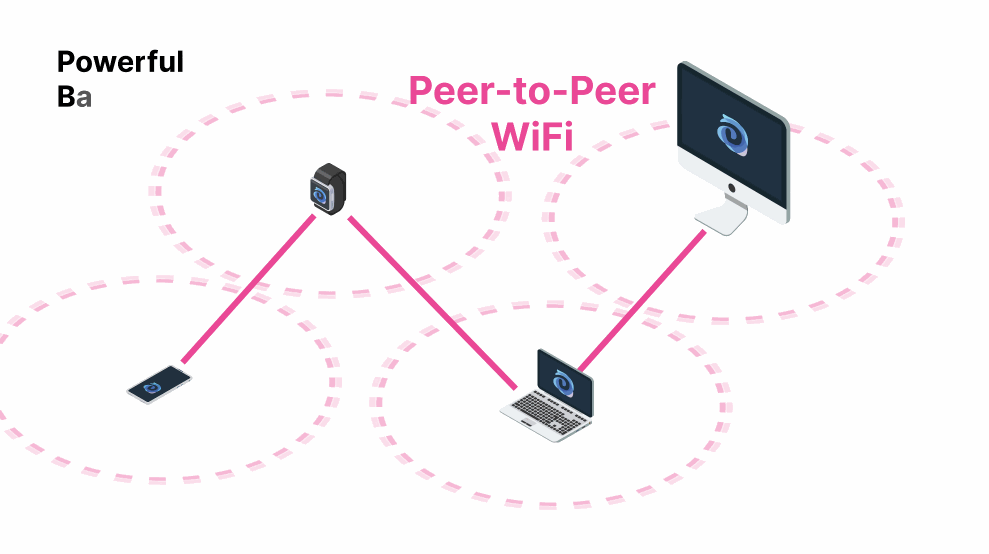Basic Concepts
Mesh Networking 101
The mesh is an underlay for data sync within Ditto, operating independently of your queries and sync subscriptions. Data updates propagate through the mesh automatically, provided your sync subscriptions match.
Whether you have two devices or two thousand devices in your mesh, Ditto incorporates several algorithms to maintain an optimal mesh network at all times.
This article provides an overview of the very basics of Ditto’s mesh technology, covering key topics such as:
 Big Peers are especially important for those who want to use Ditto in a web browser since web browsers have very limited peer-to-peer capabilities — you can configure the JavaScript SDK with the Big Peer and sync.
An SDK can sync in any of the following ways:
The following visual overview illustrates how Ditto uses Bluetooth LE to form low-powered, high-distance connections between peer devices.
Big Peers are especially important for those who want to use Ditto in a web browser since web browsers have very limited peer-to-peer capabilities — you can configure the JavaScript SDK with the Big Peer and sync.
An SDK can sync in any of the following ways:
The following visual overview illustrates how Ditto uses Bluetooth LE to form low-powered, high-distance connections between peer devices.

The following video illustrates Ditto’s sophisticated and decentralized approach to peer-to-peer Wi-Fi connections between distributed peers connected in the mesh network:
 The defining attributes of a WebSocket include:
The defining attributes of a WebSocket include:
 Flood fill, or flooding for short, is a common pattern in a mesh network topology for enhancing efficiency and reliability by ensuring data propagates across connected peers efficiently and reliably, regardless of their queries.
When flooding the mesh, data moves from one connected peer to another through intermediate “hops” along a defined path.
For example, imagine a daisy chain from point A to point B, as illustrated in the graphic on the right.
Flood fill, or flooding for short, is a common pattern in a mesh network topology for enhancing efficiency and reliability by ensuring data propagates across connected peers efficiently and reliably, regardless of their queries.
When flooding the mesh, data moves from one connected peer to another through intermediate “hops” along a defined path.
For example, imagine a daisy chain from point A to point B, as illustrated in the graphic on the right.
 Much like a conventional city map with roads, the presence graph is like a guide for peers, helping them determine the shortest and fastest paths to route updates from point A to B.
If an intermediate peer becomes unavailable, the presence graph facilitates route updates, ensuring continuous connectivity similar to navigation apps like Google Maps. This flexibility allows the multihop links, established during the flood-fill process, to adapt as devices join and leave the mesh network.
Represented by different colors in the following graphic, available transports establish multiple active connections simultaneously within the mesh:
Much like a conventional city map with roads, the presence graph is like a guide for peers, helping them determine the shortest and fastest paths to route updates from point A to B.
If an intermediate peer becomes unavailable, the presence graph facilitates route updates, ensuring continuous connectivity similar to navigation apps like Google Maps. This flexibility allows the multihop links, established during the flood-fill process, to adapt as devices join and leave the mesh network.
Represented by different colors in the following graphic, available transports establish multiple active connections simultaneously within the mesh:
 Each instance of Ditto running in your app is assigned a random universally unique identifier (UUID). This
Each instance of Ditto running in your app is assigned a random universally unique identifier (UUID). This  Partitioning and replication are central to ensuring rapid and dependable data access for your end users. With Ditto’s query subscription system, devices are able to sync both Ditto document and attachment objects efficiently and intelligently.
For a direct explanation of the query subscription system that controls Ditto’s data sync service, watch the following video on the functionality of subscriptions. In this video, the tech lead of Ditto’s replication team discusses the synchronization process between two peers — one with an empty document set and the other with seven billion documents:
Partitioning and replication are central to ensuring rapid and dependable data access for your end users. With Ditto’s query subscription system, devices are able to sync both Ditto document and attachment objects efficiently and intelligently.
For a direct explanation of the query subscription system that controls Ditto’s data sync service, watch the following video on the functionality of subscriptions. In this video, the tech lead of Ditto’s replication team discusses the synchronization process between two peers — one with an empty document set and the other with seven billion documents:
- Communication transports like Bluetooth Low Energy (LE).
- The multiplexer that enables Ditto’s rainbow connection.
- The flood-fill design pattern.
- Peer-to-peer authentication and access controls and permissions.
- Concurrency conflict-resolution strategies.
Introduction
Upon initiating the sync process by invoking thestartSync function from the top-most scope of your app, peers with the same app ID immediately form a mesh network using a mixture of communication transports, each with advantages and disadvantages. For example, Ditto prioritizes Wi-Fi for its high bandwidth and only falls back to Bluetooth LE when needed to take advantage of its longer-range capabilities.
Unlike typical home networks — which represent a star topology where all devices connect directly to a central router, switch, or access point — a peer-to-peer mesh network offers multiple pathways for communication.
Here’s a quick video overview by Ditto’s Network Transports Team Lead, Tom Karpiniec:
Transports
Ditto leverages an array of communication transports, supporting a variety of use cases and end-user devices. Communication transports are networking protocols that facilitate data transmission across different environments. For instance, using the local area network (LAN) transport for data movement in an office-like setting. Which transports Ditto supports depends on what kind of device or Small Peer SDK you are using, for example:- A mobile phone can use Bluetooth LE, LAN, Wi-Fi Direct, and WebSocket.
- A web app running in a browser can use WebSocket.
- A Raspberry Pi can use Bluetooth LE, LAN, and WebSocket.
Big Peer and On-Premises Servers
In addition to peer-to-peer transports like Bluetooth LE, you can opt to connect to a decentralized cloud deployment, which you configure by simply specifying its URL. This decentralized cloud deployment is called the Big Peer, while regular SDKs are Small Peers. Many apps need to sync data with the Big Peer, connecting your data in your mesh network with other systems running centrally in the cloud. The Ditto SDK uses peer-to-peer and Big Peer connections simultaneously, turning your mesh global. This is as easy as setting your server’s URL.
- Directly with a Big Peer
- Locally with Small Peers
- With both at the same time, acting as a bridge for devices without internet access.
Bluetooth Low Energy
Ditto utilizes both traditional Wi-Fi and Bluetooth Low Energy (LE) to maintain a continuous mesh network of Transmission Control Protocol (TCP) connections. Bluetooth LE technology forms low-powered and high-distance connections between devices, making it highly performant in offline scenarios when replicating small amounts of data.In the event of a Wi-Fi network disruption, such as a router getting disconnected, Ditto does not automatically switch transports to establish an independent Bluetooth LE connection as a fallback.Instead, Ditto actively works to maintain the previously established Wi-Fi and Bluetooth LE connections.
The distances and bandwidth limitations and capacities illustrated in the video are approximations and vary depending on the Bluetooth® firmware installed on the device.

Peer-to-Peer Wi-Fi
Available to most devices, standard peer-to-peer Wi-Fi enables direct, point-to-point connections between peers without requiring traditional network infrastructure like a centralized server, router, or access point. In addition to standard peer-to-peer Wi-Fi, Ditto incorporates a customized multiplexer to increase frequency, speed, and efficiency of data transmission between peers participating in the mesh. The following table provides an overview of the Wi-Fi technologies Ditto supports:| Platform | Ditto-Supported Technology |
|---|---|
| Apple | Apple Wireless Direct Link (AWDL) |
| Android | Wi-Fi Aware |
The maximum distance of a connection can vary depending on the specific peer-to-peer transport type being used.

Local Area Network
When devices are connected over the same Wi-Fi access point or through other means like an Ethernet cable, they can take advantage of a local area network (LAN), if available, to communicate directly with each other without requiring internet access. A LAN is an interconnected network made up of devices that are physically near each other, such as a home, enterprise, or college campus.WebSocket
Peers use WebSocket connections to enable realtime, bidirectional sync between Small Peers and the optional cloud deployment, the Big Peer.Before you can establish a connection with the Big Peer using a WebSocket, you need to specify an IP/PORT. (See Customizing Transports Configurations)
- Requires an internet connection to establish peer-to-peer communication.
- Unlike the other peer-to-peer transport types, does not automatically discover other peers physically nearby.
- WebSocket connections can be made over a Transmission Control Protocol (TCP) or Local Area Network (LAN).
Multiplexer
Ditto incorporates a *multiplexer *inside the peer-to-peer mesh network to facilitate data sync. Developed by Ditto, the multiplexer is an intelligent sync machine that seamlessly switches between active transport types as needed, without duplicating data. In addition, the multiplexer breaks down data packets into small fragments and then, once received on the other side, reassembles them.Rainbow Connection
When the transports collaborate in parallel and the multiplexer automatically switches between them to establish the most optimal connection, these diverse transport types collectively form what is known as the *rainbow connection *— each color of the rainbow symbolizes a different transport type:Flood-Fill Process
When all peers connected in the mesh need to share the same view of the data, Ditto initiates the *flood-fill *process to multihop data from one connected peer to another connected peer by way of intermediate “hops” along a given path.
Benefits of Mesh-Wide Flooding
The benefits of flooding the mesh include:- Guaranteeing a consistent offline-first sync of critical data, ensuring data remains consistent even when connectivity is intermittent.
- Improving the overall responsiveness of your app, leading to faster interactions.
- Reducing costs by optimizing data operations since, when feasible, you can read and write data to a nearby peer instead of traversing a very fragile, low‑bandwidth data source.
Preconditions to Multihop
For the multihop communication process to succeed, every peer within the chain, or connecting group, must meet the following preconditions:- Share the same subscription
- Accessible through the transport mechanism

Presence Graph
Independent of the internet, Ditto syncs data among peers by establishing sessions and forming a mesh network using all available network transports on a device. In this process, discovered peers create a presence graph by advertising and forming connections.For more information, see Using Mesh Presence.

Authentication and Access
Ditto’s security relies on digital identities for peer-to-peer authentication and access control permissions.Offline Sync Prerequisite
Before participating in a mesh and exchanging data with nearby peers, each instance of Ditto running in your app must connect to the internet at least once to establish the necessary infrastructure within the Big Peer, including generating the access credentials required to participate in the mesh and sync offline.Security of Connections
Ditto ensures the security of each connection — unlike Bluetooth Low Energy (LE), which lacks native security measures, Ditto provides each end-user device participating in the mesh with certificates signed by a root certificate identifying connecting devices. In addition, all connections between peers participating in the mesh are encrypted using Transport Layer Security (TLS) version 1.3. (See the official Transport Layer Security Wikipedia article)Approval for NSA-level encryption through collaboration with the military is in progress and is expected to be available later this year. For more information, contact Ditto. (See Contact Us)
string of alphanumeric characters uniquely identifies your app across the Ditto platform and other integrated systems and environments, including:
- Change Data Capture (CDC) in Apache Kafka, third-party databases, business intelligence tools like Microsoft BI, and so on.
- Big Peer, to establish necessary infrastructure. For instance, the Big Peer uses your app ID to identify your app before issuing your access credentials.
OnlinePlayground Authentication
Using Ditto’sonlinePlayground identity, you can sync with other peers who share the same app ID and read and write to collections without the hassle of setting up your own authentication.
Conflict-Free Sync
A challenge arises in offline scenarios when two or more peers make edits independently and the data values stored by each peer diverge over time. Referred to as conflict resolution, Ditto’s process of addressing concurrency conflicts involves a combination of a metadata database and guiding principles, as follows.Metadata Database
Each peer individually maintains its own metadata database. The metadata database serves as a storage repository of information essential in resolving conflicts that arise when merging concurrent changes. Within this metadata database is the version vector. The version vector manages the following essential details for a particular peer:- The current state of sync.
- A record of the data previously sent and received.
- The sequence of updates.
- The timestamp of last write operation.
Guiding Principles
Ditto adheres to the following strategies to ensure that all peers ultimately reach the same value for a particular data item:- Deterministic — As part of the strategy of eventual consistency, regardless of the order in which updates from different peers are received and merged, all peers ultimately converge to the same single value.
-
Predictable and Meaningful** **— Instead of arbitrarily resolving conflicting
registersto a predefined value, the resulting merge accurately represents the original input and some rational interpretation of that input.
Query Subscription System
The multiple replicas that result from a single partition are spread across virtual and relevant physical server nodes; that is, the Big Peer cloud deployment and local Ditto stores of subscribing Small Peers. By default, Ditto does not automatically replicate data to peers. Instead, peers subscribe to changes and, using a query that you’ve defined, indicate the data they’re interested in watching for changes. Once a change is observed somewhere in the mesh, only the delta matching your query replicates to other subscribing peers. In simpler terms, sync involves a subscribing peer selectively “pulling” data from other peers, rather than remote peers automatically “pushing” data to it.
Transports Configurations
The Ditto SDK features a configuration structure calledTransportConfig, which is stored within the main Ditto object. By default, if you don’t make any changes to this configuration, Ditto will automatically enable all available peer-to-peer transports.
If you create a new TransportConfig, it has three main sections:
peerToPeerconnectlisten
peerToPeer and WebSocket settings. For instructions, see Customizing Transports Configurations.
Use the
listen parameters designated for scenarios, like web browser clients operating on fully offline networks, only when explicitly instructed by Ditto support.Misconfiguring these listener features may bypass Ditto’s standard encryption and access control mechanisms, leading to potential security vulnerabilities.
